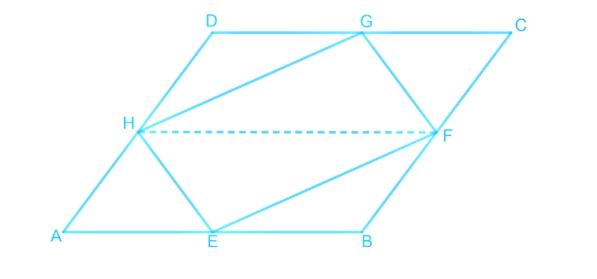If E,F,G and H are respectively the mid-points of the sides of a parallelogram ABCD, show that ar(EFGH)=12ar(ABCD).
Let us join HF.
In parallelogram ABCD,
AD=BC and AD∣∣BC(Opposite sides of a parallelogram are equal and parallel)
AB=CD (Opposite sides of a parallelogram are equal)
⇒12AD=12BC and AH∣∣BF
⇒AH=BF and AH∣∣BF(Since H and F are the mid-points of AD and BC)
Therefore, ABFH is a parallelogram.
Since ΔHEF and parallelogram ABFH are on the same base HF and between the same parallel lines AB and HF,
∴Area(ΔHEF)=12Area(ABFH) .....(1)
Similarly, Area(ΔHGF)=12Area(HDCF) .....(2)
On adding Equations (1) and (2), we obtain
Area(ΔHEF)+Area(ΔHGF)=12Area(ABFH)+12Area(HDCF) ...... (3)
From the figure, we can see that,
Area(ΔHEF)+Area(ΔHGF)=Area(EFGH)....... (4)
12Area(ABFH)+12Area(HDCF)=12Area(ABCD) ..... (5)
From (3) & (4) and (5) we have,
Area(EFGH)=12Area(ABCD)

Similar Questions
If E,F,G and H are respectively the mid-points of the sides of a parallelogram ABCD, show that ar(EFGH)=12ar(ABCD).
View SolutionIf E, F, G and H are respectively the mid-points of the sides of a parallelogram ABCD, Show that ar(EFGH)=12AR (ABCD)
View SolutionE,F,G,H are respectively, the mid-points of the sides AB,BC,CD and DA of parallelogram ABCD . Show that the quadrilateral EFGH is a parallelogram and that its area is half the area of the parallelogram, ABCD. GIVEN : A quadrilateral ABCD in which L,F,G,H are respectively the mid-points of the sides AB,BC,CD and DA. TO PROVE : (i) Quadrilateral EFGH is a parallelogram ar(^(gm)EFGH)=12ar(^(gm)ABCD) CONSTRUCTION : Join AC and HF
View SolutionD, E and F are respectively the mid -points of the sides BC, CA and AB of a △ABC .Show that (i) BDEF is a parallelogram
View SolutionD, E and F are respectively the mid-points of the sides BC, CA and AB of aΔABC.Show that (i) BDEF is a parallelogram. (ii) ar (DEF)=14ar (ABC)(iii) ar (BDEF)=12ar (ABC)
View Solutionp AND q are any two points lying on the sides DC and AD respectively of a parallelogram ABCD. Show that ar(APB)=ar (BQC).
View SolutionIn A ABC , P and Q are respectively the mid-points of AB and BC and R is the mid-point of AP. Prove that: ar(PRQ)=12ar(ARC)
View SolutionIn a parallelogram ABCD,E,F are any two points on the sides AB and BC respectively. Show that ar(ADF)=ar(DCE).
View SolutionD, E, F are the mid-points of the sides BC, CA and AB respectively of a ABC . Determine the ratio of the areas of DEF and ABC .
View SolutionIn Fig. 4.103, CD and GH are respectively the medians of ABC and EFG . If ABC~FEG , prove that (FIGURE) ADC~FHG (ii) CDGH=ABFE (iii) CDB~GHE
View Solution